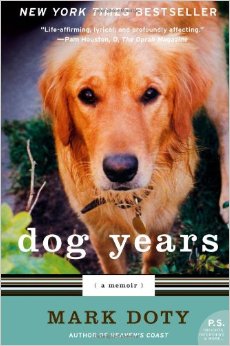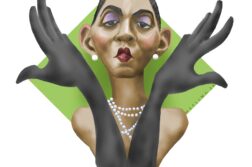 A Queer History of the Ballet
A Queer History of the Ballet
by Peter Stoneley
Routledge. 206 pages, $29.95
Just when one had lost hope in queer theory and its future, this book clearly points toward its utility when applied with skill and insight. Making his focus the great Romantic ballets of the 19th century and giving them a close reading as queer texts, Stoneley reflects on the homosexual imaginations of the men who created these works and shaped them into high art. With a wealth of biographical knowledge and creative thought, Stoneley gives us the odd Jungian archetypes of gay ballet culture, everything from phallic swans to unobtainable fairy lovers, to the cult of the prima ballerina and her tragic role as hyper-feminine object of desire. Artists as diverse as Tchaikovsky, Hans Christian Andersen, and Diaghilev are discussed from a queer perspective. We learn of backstage bickering, gay romances, and suppressed homoerotic longings. The cult of Margot Fonteyn is contextualized as a gay icon (as per the theories of Wayne Koestenbaum). Lincoln Kirstein, through his odd collaboration with Balanchine, is credited with creating a uniquely American ballet, one queer enough to include sets and costumes by Paul Cadmus and choreography by Jerome Robbins. If the book somewhat draws thin toward the contemporary period, there is still enough to build upon in its precise study of ballet’s origins.
Walter Holland
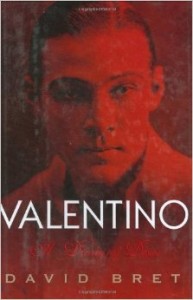 Valentino: A Dream of Desire
Valentino: A Dream of Desire
by David Bret
Carroll & Graf. 224 pages, $25.95
This new book on Rudolph Valentino has the appeal of a silent film, with all the histrionics, scenery changes, and implausible plotlines that this implies. Here’s a gay, lesbian, and bisexual Hollywood of the early 1920’s as we have never seen it before. Not since Vito Russo’s The Celluloid Closet has there been such an inviting glimpse of closeted Hollywood in its early days. Here also are New York’s shadowy turn-of-the-century dance halls crowded with thugs and hustlers, places where tango dances with wealthy matrons led to hurried tips and late-night rendezvous. And here is Valentino, who, through a succession of male lovers and female “beards,” slept his way from New York to Hollywood. Bret coos and gushes over his subject, reminding us often of Valentino’s aristocratic looks and famous endowment. We learn of his first marriage to the lesbian actress Jean Acker. We’re treated to a smorgasbord of his male conquests, including a steady series of fuck-buddies such as Paul Ivano, André Draven, Robert Florey, and Frank Menillo. We relive his second, tempestuous marriage to Winifred Shaughnessy—a.k.a. Natacha Rambova—the stepdaughter of a Salt Lake City cosmetics tycoon, Richard Hudnut. While Bret provides plenty of salacious gossip, he sometimes withholds his sources. We’re left at times with what might be called star fatigue—a sense of being served up an old rehash of celebrity magazines filled with tales of sexual prowess, wild marriages, and reckless deaths (Valentino died at 31). But if you can keep your motoring cap on and your goggles tight, this is a wild ride with plenty of kiss-and-tell. Where else can you run into Gary Cooper with his boyfriend and spend an evening at the Torch Club in the infamous Room 23, where a two-way mirror over the bed afforded a hot ticket to the nightly bacchanal?
Walter Holland
 Dog Years
Dog Years
by Mark Doty
HarperCollins. 224 pages, $23.95
The third memoir by poet and essayist Mark Doty is undoubtedly the one that has the greatest potential to reach a mainstream audience. While the enduring subject of “man’s best friend” may spark the interest of a wider demographic, it could in the wrong hands be an inherently limiting topic. All the more impressive, then, that Doty achieves the depth and variety that he does in Dog Years. A personal narrative of the sixteen years spent with his black retriever Arden and his golden retriever Beau—as well as with his late partner, Wally Roberts, and his current partner, fiction writer Paul Lisicky—the memoir finds Doty matter-of-factly incorporating the gay angles into his tale. He also presents Arden and Beau as developed characters without overly anthropomorphizing them. (Arden, late in his long life, earns the tongue-in-cheek nickname “the Everlasting Beyoncé.”) Traveling from Vermont to Provincetown to New York to Houston, the story does get a bit bogged down by workaday details: visits to the vet, drug regimens for the aging, beloved pets. Doty hits his stride during the book’s more reflective, philosophical passages. In a short yet profound meditation on an old photo of the two dogs walking up a snowy Provincetown street (which is also the book’s cover image), Doty writes: “If you could stand at just a little distance in time, how fluid and shape-shifting physical reality would be, everything hurrying into some other form.” As always, he gracefully locates the consolation in evanescence, even when dealing with the harrowing events of 9/11, that bookend the memoir. Dog Years leaves little doubt that Doty is one of our most accessible deep observers, and this book recreates—to borrow the title of a pet-centered film to which Doty himself refers—an incredible journey.
Jason Roush
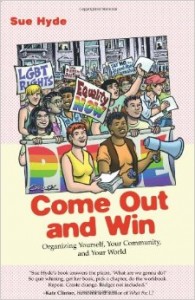 Come Out and Win: Organizing Yourself,
Come Out and Win: Organizing Yourself,
Your Community and Your World
by Sue Hyde
Beacon Press. 168 pages, $13. (paper)
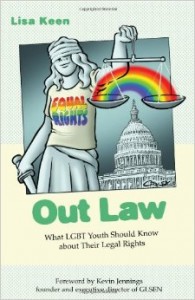 Out Law: What LGBT Youth Should Know about Their Legal Rights
Out Law: What LGBT Youth Should Know about Their Legal Rights
by Lisa Keen
Beacon Press. 158 pages, $13. (paper)
Two colorful books by lesbian activists have been published by Boston-based Beacon Press, an affiliate of the Unitarian-Universalist Church that publishes a number of GLBT books as part of its generally left-tilting line-up. They are the latest books in a series called “Queer Action/Queer Ideas.” The first, Come Out and Win, is by Sue Hyde of the National Gay and Lesbian Task Force. The second, Out Law, by the venerable Lisa Keen, delves into the fluid legal waters of GLBT rights and protections. Informative yet approachable, both books provide a roadmap for how the GLBT community can continue to march forward with the resources we have acquired to date. Hyde extends to her readers every avenue for civic engagement: how to organize on campus; how to write a letter to the editor; how to run for office yourself; and so on. Keen, targeting a young adult readership, discusses judicial milestones such as Lawrence v. Texas, the 2003 Supreme Court decision that struck down as unconstitutional all state and local laws against “sodomy.” She also confronts the reality of an ultra-conservative Supreme Court headed by John Roberts with its “originalist” interpretation of the Constitution, and considers how we can best cope with this situation. And while the high court is likely to remain conservative for some time to come, both Hyde and Keen look forward to an era of significant legislative gains and, with any luck, a change in the executive branch as of next November. But, of course, most of the important action will continue to happen on the state and local level as more states ban employment discrimination and inch toward a legal recognition of same-sex relationships.
Thomas E. Kilduff


